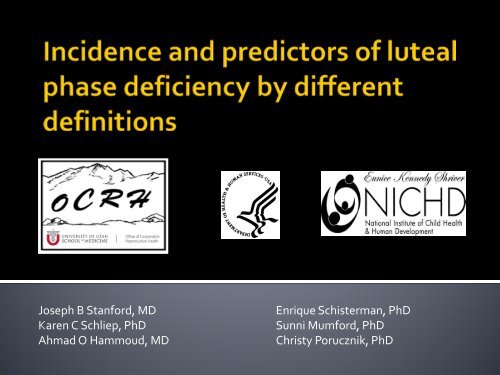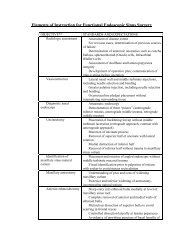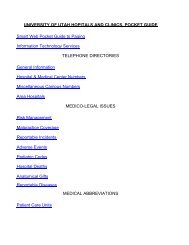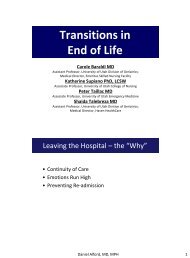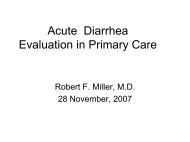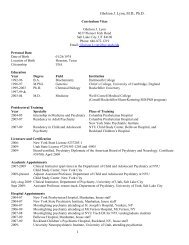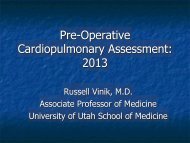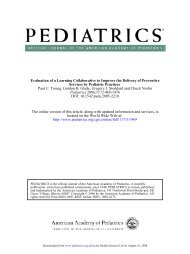Incidence and predictors of luteal phase deficiency by different ...
Incidence and predictors of luteal phase deficiency by different ...
Incidence and predictors of luteal phase deficiency by different ...
Create successful ePaper yourself
Turn your PDF publications into a flip-book with our unique Google optimized e-Paper software.
Joseph B Stanford, MD<br />
Karen C Schliep, PhD<br />
Ahmad O Hammoud, MD<br />
Enrique Schisterman, PhD<br />
Sunni Mumford, PhD<br />
Christy Porucznik, PhD
Menstrual cycle ovulatory disorders range<br />
from <strong>luteal</strong> <strong>phase</strong> <strong>deficiency</strong> (LPD) to more<br />
advanced cases <strong>of</strong> anovulation.<br />
Alterations in life style (exercise, diet, <strong>and</strong><br />
stress) <strong>and</strong> abnormal endocrine dynamics are<br />
known to cause anovulation; however, their<br />
role in milder menstrual cycle phenotypes<br />
such as LPD is less known.
Clinically, LPD may be associated with:<br />
1. abnormal <strong>luteal</strong> <strong>phase</strong> progesterone <strong>and</strong> estradiol<br />
(E2) production<br />
2. shortening <strong>of</strong> the menstrual cycle (<strong>by</strong> shortening<br />
<strong>of</strong> the <strong>luteal</strong> <strong>phase</strong>)<br />
3. premenstrual spotting or bleeding<br />
4. pregnancy related disorders such as infertility (via<br />
impairment <strong>of</strong> endometrial development) <strong>and</strong><br />
early pregnancy loss.
While LPD is thought to occur in 3-20% <strong>of</strong><br />
women who are infertile <strong>and</strong> in 25-60% <strong>of</strong><br />
women with recurrent spontaneous abortion,<br />
data also suggest that 6-10% <strong>of</strong> women with<br />
normal fertility demonstrate an inadequate<br />
<strong>luteal</strong> <strong>phase</strong>.<br />
There is a need, thus, to better underst<strong>and</strong><br />
normal variations in the menstrual cycle<br />
<strong>phase</strong>s <strong>and</strong> in variations that could be<br />
pathologic.
Assess <strong>luteal</strong> <strong>phase</strong> function in the BioCycle<br />
Study <strong>by</strong> determining cycles with:<br />
1. Short <strong>luteal</strong> <strong>phase</strong>s (< 10 days in length)<br />
2. <strong>Incidence</strong> <strong>of</strong> premature luteinization (evidenced<br />
<strong>by</strong> a late follicular rise in progesterone before<br />
ovulation)<br />
3. Premenstrual spotting<br />
4. Abnormal <strong>luteal</strong> <strong>phase</strong> progesterone
1. Some normal cycling women express<br />
evidence <strong>of</strong> subtle menstrual cycle disorders<br />
manifested as LPD.<br />
2. Various demographic, lifestyle,<br />
environmental, <strong>and</strong> nutritional factors<br />
increase the incidence <strong>of</strong> LPD.
BioCycle Study (2005-2007): Followed 259 women<br />
from NY region for two menstrual cycles<br />
Inclusion:<br />
Ages 18-44<br />
Regularly menstruating<br />
Exclusion:<br />
Conditions known to affect menstrual cycle function<br />
Self-reported over- or underweight or unusual diet<br />
Strong compliance: 250 completed two cycles; 9<br />
completed one cycle
BioCycle women with cycles <strong>of</strong> known length<br />
(as determined <strong>by</strong> daily records <strong>of</strong> menstrual<br />
bleeding) who reached peak fertility via<br />
Clearplan® fertility monitor (based on E3G<br />
<strong>and</strong> LH in urine) OR who reached an LH peak<br />
serum surge > 19 ng/mL (for women not<br />
peaking via the monitor or with cycle lengths<br />
≥30 days)<br />
n=241 women, 406 cycles
Observed day <strong>of</strong> ovulation (i.e., urine or serum<br />
LH surge + 1 day) was used to classify visits into<br />
correct cycle <strong>phase</strong> categories.<br />
Cycle length was defined as number <strong>of</strong> days between<br />
menstrual bleeding.<br />
Day 1 <strong>of</strong> the cycle was defined as menstruating <strong>by</strong><br />
4pm on that day (after confirming 2 consecutive days<br />
<strong>of</strong> bleeding).<br />
Follicular length: Day 1 <strong>of</strong> bleeding through day <strong>of</strong><br />
ovulation.<br />
Luteal length: Day after ovulation through last day <strong>of</strong><br />
cycle.
Based on previous research, we defined LPD in 5<br />
unique ways:<br />
1. Luteal <strong>phase</strong> duration < 10 days in length.<br />
2. Deficient <strong>luteal</strong> <strong>phase</strong> progesterone production via<br />
AUC analysis (i.e., lowest quintile).<br />
3. Deficient <strong>luteal</strong> <strong>phase</strong> progesterone production via<br />
cutpoint (i.e., ≤ 5 ng/mL for all 3 <strong>luteal</strong> visits).<br />
4. Progesterone ≥ 2ng/mL before ovulation.<br />
5. Premenstrual spotting (defined as ≤ 2 consecutive<br />
days <strong>of</strong> menstrual bleeding).
Data on potential<br />
confounders were<br />
collected <strong>by</strong><br />
anthropometric<br />
measurement (height<br />
<strong>and</strong> weight),<br />
questionnaires (lifestyle,<br />
physical activity, <strong>and</strong><br />
reproductive history), or<br />
interview (demographic<br />
<strong>and</strong> dietary information).
Descriptive statistics <strong>by</strong> LPD for all 3<br />
definitions were computed for potential<br />
confounding variables <strong>and</strong> menstrual cycle<br />
characteristics (i.e., overall cycle length,<br />
premenstrual spotting, <strong>and</strong> geometric mean<br />
hormone levels) taking into account multiple<br />
cycles from the same women.
Nonlinear harmonic models were used to<br />
assess the association between LPD <strong>and</strong><br />
hormonal patterns.<br />
All models were adjusted for age, BMI, race.<br />
We used centered models for mean <strong>and</strong><br />
amplitude <strong>and</strong> non-centered models for<br />
<strong>phase</strong> shift assessment.
Luteal <strong>phase</strong><br />
< 10 days<br />
Luteal<br />
progesterone<br />
n=328 cycles<br />
Luteal<br />
<strong>phase</strong><br />
length
Luteal <strong>phase</strong> < 10 days<br />
Significantly (P
Estradiol<br />
Luteal <strong>phase</strong> < 10 days Luteal AUC progesterone < 54.5 ng/mL<br />
Luteal progesterone < 5 ng/mL<br />
Mean<br />
P=0.008
LH<br />
Luteal <strong>phase</strong> < 10 days Luteal AUC progesterone < 54.5<br />
Luteal progesterone < 5 ng/mL<br />
Amplitude<br />
P=0.12
FSH<br />
Luteal <strong>phase</strong> < 10 days Luteal AUC progesterone < 54.5<br />
Luteal progesterone < 5 ng/mL<br />
Mean<br />
P
Progesterone<br />
Mean<br />
P=0.02<br />
Amplitude<br />
P=0.03<br />
Luteal <strong>phase</strong> < 10 days
Findings suggest that normal cycling women<br />
do express evidence <strong>of</strong> subtle menstrual cycle<br />
disorders manifested as LPD.<br />
Age, race, sleep, <strong>and</strong> dietary factors (e.g.,<br />
fiber intake) may be associated with LPD in<br />
normal cycling women.<br />
LPD may express itself in <strong>different</strong> ways,<br />
potentially through <strong>different</strong> mechanisms.
Decreased E2 across the cycle significantly<br />
associated with deficient <strong>luteal</strong> progesterone<br />
production.<br />
Increased FSH significantly associated with<br />
short <strong>luteal</strong> <strong>phase</strong> duration <strong>and</strong> deficient<br />
<strong>luteal</strong> progesterone production.<br />
Decreased progesterone significantly<br />
associated with short <strong>luteal</strong> <strong>phase</strong> duration.
Need for a better diagnostic test to assess<br />
<strong>luteal</strong> <strong>phase</strong> insufficiency.<br />
LPD, an independent entity causing<br />
infertility, has not been proven.<br />
While we show here that LPD is present in<br />
normal cycling women, we cannot infer if it is<br />
pathological in regards to fertility.
Further research is needed to assess what<br />
factors influence LPD, so that preventive<br />
strategies via lifestyle modifications or<br />
minimally invasive therapeutic treatments<br />
might be implemented for women suffering<br />
from reproductive disorders due to LPD.


